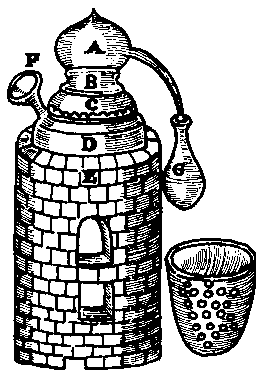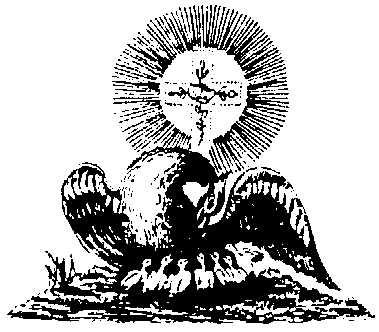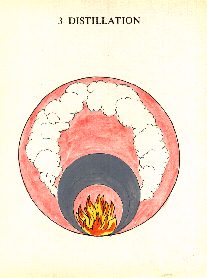Writings about Alchemy
by Adam McLean
Adam McLean
Adam McLean - alchemy@dial.pipex.com
I
have been writing and researching alchemical and
hermetic literature for many years and between
1978 and 1992 edited the Hermetic Journal. I also
published during those years the Magnum Opus Hermetic
Sourceworks
a series of twenty-five editions of
key source texts of the hermetic tradition. In
the course of my research I often come across
important texts, both in printed books and
manuscripts, which have been neglected. Some of
these I have transcribed and eventually I hope to
publish these in the revived Magnum Opus Hermetic
Sourceworks and other related series which I sell
through my alchemy web bookshop. An
important part of my work is to attempt an
analysis of and commentary on the ideas and
symbolism of key hermetic works. I am especially
drawn to the rich vein of allegorical and
symbolic material in the alchemical tradition. I
recently returned to producing paintings based on
alchemical emblems.
http://www.levity.com/alchemy/adam.html
 Coloured alchemical emblems Coloured alchemical emblems
Adam McLean - alchemy@dial.pipex.com
Over
the past ten years or so I have been making
handcoloured emblems by painting with
watercolours copies of woodcuts and engravings
from printed books and some manuscript drawings.
In colouring these I made use of my intensive
study of the original coloured manuscripts of the
15th to 18th centuries, which have been the main
focus of my research over the past years.
I have often found that by contemplating and
meditating on these handcoloured images one can
resonate with and enter into the complex symbolic
world of alchemy.
http://www.levity.com/alchemy/amcldraw.html
Magnum Opus Hermetic Sourceworks
Adam McLean - alchemy@dial.pipex.com
The Magnum
Opus Hermetics Sourceworks is a series of
primary texts relating to the Hermetic tradition.
The original series of twenty-three volumes was
published between 1979 and 1987 by Adam McLean.
Each work was edited or translated from original
source material, and many of the volumes
contained extensive commentaries and introductory
material. These were issued in small editions of
250 signed and numbered copies, handbound by the
editor.
http://phanes.com/magnum-opus.html
A Threefold Alchemical Journey Through
the Book of Lambspring
Adam McLean - alchemy@dial.pipex.com
The
Book of Lambspring is well known as one of the
gems from the Musaeum Hermeticum published
in 1625 by Lucas Jennis in Frankfurt, especially
for its series of fifteen emblematic plates. It
seems that this little book was first published,
under the title De Lapide Philosophico Triga
Chemicum (Prague 1599) compiled by the
Frenchman Nicolas Barnaud prominent in the
alchemical circles around Rudolf II.
The Book of Lambspring is a short
work with an introductory section in verse and an
emblem showing a threefold furnace. Following the
tradition of emblem books of the period its
series of fifteen emblems each bears a motto or
title with a verse on the facing page. The Book
of Lambspring is a work of spiritual alchemy, has
few references to physical alchemical processes,
and it seems unlikely that it could ever have
provided any clues that might help someone
engaged upon physical experimentation. Instead,
it is a clear, powerful and extremely useful
statement of the inner work of the spiritual
alchemist. Its verses point to the soul and
spirit involved in the alchemical transformation
and its fifteen emblems are evocative symbols of
these inner processes.
http://www.levity.com/alchemy/lambjrny.html
 The Alchemical Drama of Goethe's Faust The Alchemical Drama of Goethe's Faust
Adam McLean - alchemy@dial.pipex.com
The alchemy in Goethe’s Faust
is central to its dramatic conception, and is not
merely added for effect. For Goethe’s
working of the Faust story differs from other
dramas based on the archetypal legend of a
conjuror who sells his soul to the devil, sealing
his pact with a drop of blood, ultimately to
suffer the fires of Hell, in that Goethe reveals
through his drama various transformational
processes working in the human soul, personified
in Faust. Goethe struggles to weave the personal
inner journey of Faust towards some
enlightenment, together with the collective
social forces that are undergoing transformation
through the historical process, so here Faust is
also a representative of Northern European
humanity striving for evolution from the
limitations and strictures of the 16th century
Reformation to the new aspirations of humanity
that Goethe saw developing during the 18th
century Enlightenment era.
The main characters in the play are thus polarised facets of the
one human soul, whose journey to enlightenment is demonstrated in
the drama. 
Helen
Homunculus - Faust - Mephistopheles
Gretchen
We can see Faust as the core of a
complex being living within a net of polarities.
Helen the ideal archetypal feminine, and Gretchen
the earthly female from which he cuts himself
off. Homunculus a potential inner hermaphroditic
soul guide, whom he could have developed in his
being had he stuck to his alchemical work,
however, he turns to the Mephisto facet for
guidance. At the end of the play he has been
stripped of all these polarities and lies open
and vulnerable in death.
Goethe always tried purposively to
mystify his audiences and readers, as he wanted
to lead them beyond intellectual appraisal of his
ideas. To grasp the allegorical riddles in Faust
requires no mere intellectual analysis of the
drama and characters but an encounter with the
Mephisto, Gretchen, Helen, Homunculus as well as
the Faust within ourselves.
http://www.levity.com/alchemy/faust.html
 The Alchemical Vessel as Symbol of the
Soul The Alchemical Vessel as Symbol of the
Soul
Adam McLean - alchemy@dial.pipex.com
As
students of the hermetic tradition we all
recognise that the alchemical work takes place on
many different levels - the physical work with
substances, the experience and manipulation of
etheric forces, the interior work on the soul, as
well as the spiritual and planetary/cosmic
aspects of alchemy. These different facets of the
work interpenetrate and overlap each other.
Indeed, in a sense, if we are to make any
progress in alchemy, we must pursue the different
facets concurrently, paralleling interior
development with experience of the outer work.
One symbol that belongs to all these different
realms of this work is that of the alchemical
vessel. In this article I would like to outline
some ways in which we can use this symbol in our
inner exercises.
http://www.levity.com/alchemy/vessel.html
Animal Symbolism in Alchemy
Adam McLean - alchemy@dial.pipex.com
Alchemy,
as I perceive it, is a spiritual tradition, a
means for exploring our inner space and the
layers which clothe the precious essence of our
innermost soul. It is a path, a way, a practical
method for investigating the substance of our
being, by meditating upon chemical processes.
They used events in their experiments as seed
images for meditations, forming visual mantras
from chemical changes. The alchemists reflected
and mirrored these outward events into their
interior world. They saw the processes in their
flasks as an interaction and linking of the
spiritual and the material. As the alchemists
reworked these experiments over in their souls,
they further drew parallels with the greater
laboratory of Nature. They saw the work within
their flasks as a kind of microcosm of
macrocosmic Nature. The living energies and
beings in Nature were metaphorically drawn into
their retorts, as they began to picture the
living alchemical processes through animal
symbols. It was the coherence and universality of
this set of alchemical symbols that lead Carl
Jung to the concept of the collective
unconscious. The alchemists though pursuing their
inner work independently as individuals,
nevertheless found in their interior descent a
coherent language of symbols.
http://www.levity.com/alchemy/animal.html
The Birds in Alchemy
Adam McLean - alchemy@dial.pipex.com
 In
alchemical writings we meet a seemingly
bewildering multiplicity of animal symbols - red
lions, white eagles, stags, unicorns, winged
dragons and snakes. Although at first glance all
this complex mass of symbolism seems tortured and
confused there is an inner coherence to these
symbols, which the ancient alchemists used in
specific ways reflecting their esoteric content.
In this article I wish to consider a particularly
tight knit group of these animal symbols, the
birds of alchemy - the Black Crow, White Swan,
Peacock, Pelican, and Phoenix - which are
descriptive of certain stages of the alchemical
process. Of course it would be wrong to suggest
that there are fixed rigid meanings with regard
to these symbols. The alchemists always
integrated the symbols they used, so that one has
to look at the total context, the background
against which they stand, but when the birds
appear in this sequence it is almost certain that
the following interpretation can be applied: In
alchemical writings we meet a seemingly
bewildering multiplicity of animal symbols - red
lions, white eagles, stags, unicorns, winged
dragons and snakes. Although at first glance all
this complex mass of symbolism seems tortured and
confused there is an inner coherence to these
symbols, which the ancient alchemists used in
specific ways reflecting their esoteric content.
In this article I wish to consider a particularly
tight knit group of these animal symbols, the
birds of alchemy - the Black Crow, White Swan,
Peacock, Pelican, and Phoenix - which are
descriptive of certain stages of the alchemical
process. Of course it would be wrong to suggest
that there are fixed rigid meanings with regard
to these symbols. The alchemists always
integrated the symbols they used, so that one has
to look at the total context, the background
against which they stand, but when the birds
appear in this sequence it is almost certain that
the following interpretation can be applied:
The essential thing about birds is that they,
having as their domain the air element, mediate
between the earthly realm and the heaven world.
The alchemist in observing the flight of birds,
recognised in them a picture of the human soul
undergoing spiritual development. The soul,
aspiring upwards, flying free of the restraints
of the earth bound body seeking the heavenly
light, only to have to return to the earthly
consciousness again after the meditation, the
alchemist symbolised by the bird.
http://levity.com/alchemy/alcbirds.html
 The Crowning of Nature The Crowning of Nature
Adam McLean - alchemy@dial.pipex.com
The
Crowning of Nature is one of the most important
alchemical manuscripts, and contains a famous
series of 67 illustrations of the alchemical work
taking place in flasks. The following pages are
based on the Magnum Opus Hermetic Sourceworks
edition of 1980. The coloured figure included are
my own redrawing of the coloured figures, based
on a number of manuscripts.
http://www.levity.com/alchemy/crowning.html
The Inner Geometry of Alchemical Emblems
Adam McLean - alchemy@dial.pipex.com
Over the past five years of the
Hermetic Journal, I have often illustrated in the
Alchemical Mandala feature and other articles the
profound symbolism wrapped up in the old
sixteenth and seventeenth century emblematic
engravings of alchemists and Rosicrucians. I have
sometimes indicated how certain of these diagrams
can be seen to have an underlying geometric
skeleton structure upon which the symbols are
arrayed. However, I never analysed this aspect in
great depth and merely pointed out some simple
geometric features. I had not considered that
this aspect was of paramount importance, until I
recently requested from the British Library a
microfilm of an important Rosicrucian book in
their collection, the 'Speculum Sophicum
Rhodo-Stauroticum' of Theophilus Schweighardt,
published in 1618.
http://www.levity.com/alchemy/innergeo.html
Kabbalistic Cosmology
Adam McLean - alchemy@dial.pipex.com
In earlier articles I have tried to
point out the links between hermetic and
alchemical ideas and the developing current of
thought in modern physics and cosmology. In this
present piece I would like to pursue the strange
parallels between the late 16th century
reformation of kabbalistic cosmology that arose
through the insights of Isaac Luria, and the
recent reformulation of the ‘big-bang’
into the so-called ‘inflationary model’
of cosmic creation.
http://www.levity.com/alchemy/luria.html
Quantum Consciousness
Adam McLean - alchemy@dial.pipex.com
The hermetic tradition has long been
concerned with the relationship between the inner
world of our consciousness and the outer world of
nature, between the microcosm and the macrocosm,
the below and the above, the material and the
spiritual, the centric and the peripheral. There
was a grand platonic metaphysical clockwork, as
it were, through which our inner world was linked
by means of a hierarchy of beings and planes to
the highest unity of the Divine.
This view though comforting is philosophically
unsound, and the developments in thought since
the early 17th century have made such a hermetic
world view untenable and philosophically naive.
So do we now have to abandon such a beautiful and
spiritual world view and adopt the prevailing
reductionist materialist conception of the world
which has become accepted in the intellectual
tradition of the West ? I am not so sure. There
still remains the problem of our consciousness
and its relationship to our material form - the
Mind / Brain problem. In treating our
consciousness as if it were a digital computer or
deterministic machine after the model of 19th
century science, I believe we foster a limited
and false view of our inner world. We must now
take the step towards a quantum view of
consciousness, recognising that at its base and
root our consciousness behaves like the ever
flowing sea of the sub-atomic world. The ancient
hermeticists pictured consciousness as the
"Inner Mercury". The brain can no
longer be seen as a vast piece of organic
clockwork, but as a subtle device amplifying
quantum events. If we trace a nerve impulse down
to its root, there lies a quantum uncertainty, a
sea of probability. The inner sea of quantum
effects in our brain is in some way coupled to
our ever flowing consciousness. The central point
within our consciousness, our "spirit"
in the hermetic sense, can now be seen as an
entity that can work to control quantum
probabilities. To our "spirits" our
brain is a quantum sea providing a rich realm in
which it can incarnate and manifest patterns down
into the electrical/chemical impulses of the
nervous system.
We are challenged by quantum theory to build new
ways in which to picture reality, a physics,
moreover, in which consciousness plays a central
role, in which the observer is inextricably
interwoven in the fabric of reality. In a sense
it may now be possible to build a new model of
quantum consciousness, compatible with
contemporary physics and which allows a space for
the inclusion of the hermetic idea of the spirit.
http://www.levity.com/alchemy/quantum.html
Bacstrom's Rosicrucian Society
Adam McLean - alchemy@dial.pipex.com
Dr Sigismund Bacstrom was one of the
most important scholars of alchemy in the last
few centuries, being active at the end of the
eighteenth and the beginning of the nineteenth
century. Little is known of his life, except that
he was probably of Scandinavian extraction, and
that he spent a deal of his early life travelling
around the world as a ship's surgeon. Later he
was to settle in London and gather around him a
small circle of contacts (including Ebenezar
Sibley and General Rainsford), amongst whom he
circulated a number of his own translations of
alchemical texts from Latin, German, and French
into English.
On 12th September 1794, Dr Sigismund
Bacstrom was initiated into a Societas Roseae
Crucis by Comte Louis de Chazal, on the island of
Mauritius. The Count, then a venerable old man of
some 96 years, seemed to have recognised in
Bacstrom, his greatness as an hermetic student,
and offered to take him on as a pupil and teach
him the great work, and during this period,
Bacstrom was allowed to perform a transmutation
under Chazal's guidance and using his substances.
Chazal seems to have obtained his own alchemical
knowledge while he was in Paris in 1740, and J.W.
Hamilton Jones in his edition of Bacstrom's
Alchemical Anthology (1960 Stuart and
Watkins, London) even suggests that his teacher
was the Comte de St Cermain. Perhaps we have in Bacstrom
a direct connection through Chazal and the Comte
de St Germain with a continuing stream of
Rosicrucian mystery wisdom.
http://www.levity.com/alchemy/bacstrm1.html
|



